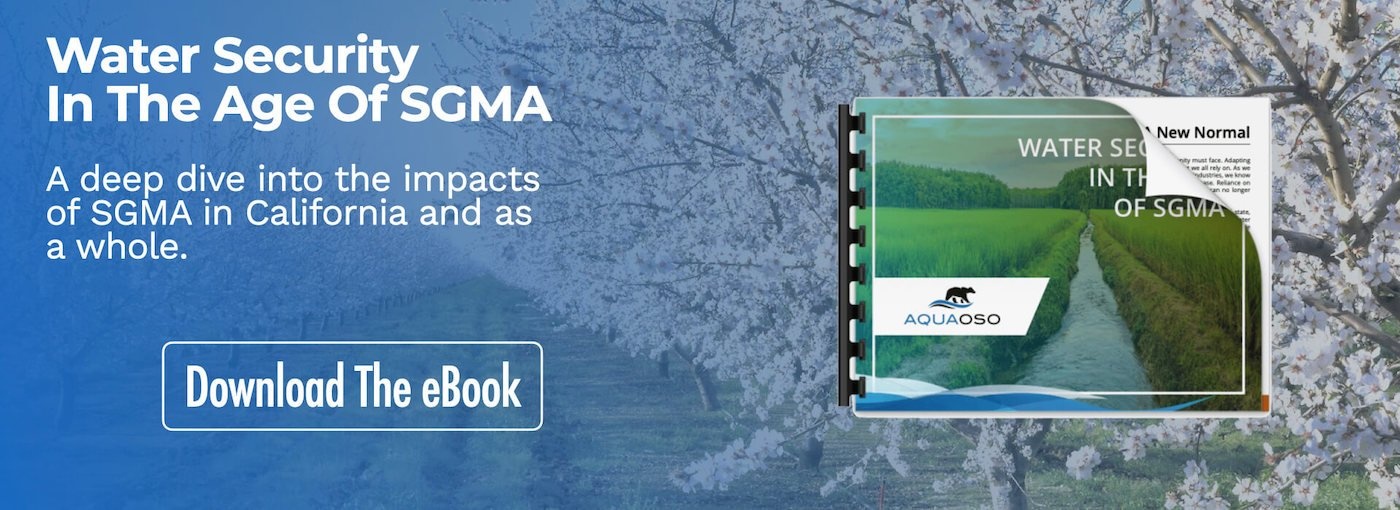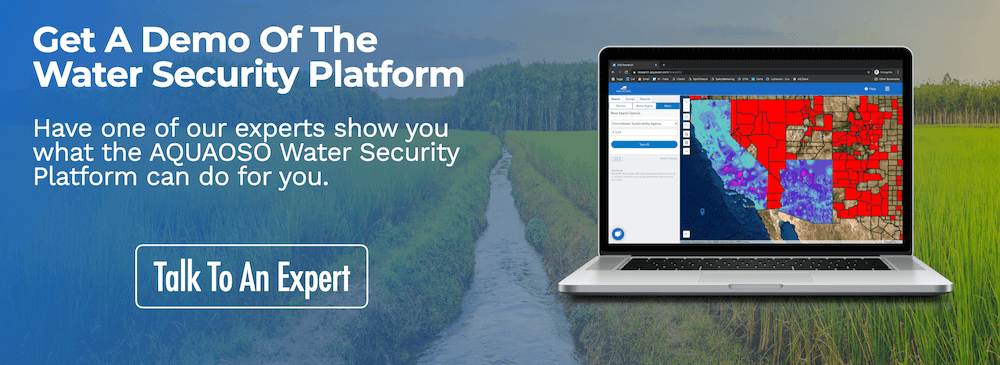Sustainable Water Practices Can Be Driven With Ag Lending Relationships
Water stress is a growing concern in some of the country’s most productive agricultural regions, but not all growers and crops will be impacted in the same way. As the U.N.’s Principles for Responsible Investment blog explains,
“Water risk comes in several forms. A company can be exposed to physical, regulatory, and reputational water risks through its agricultural operations and supply chains, which can manifest in financial impact.”
Once a lender factors water risk into their portfolio, they can be more selective about which farming operations they lend to. Farms that haven’t yet implemented sustainable water practices, or that are in a region with a high risk of drought or water stress, may lose value over time. However, succumbing to water risk doesn’t necessarily have to happen, and a grower can take steps to mitigate their water risk in the future, with the right resources. Typically these resources come in the form of relationships, technology, human capital and financial capital.
This post discusses how agricultural lenders can not only reduce water risk, but be leaders in water resilience by building relationships with borrowers to encourage them to implement sustainable water practices.
(Part of our Agriculture Loans and Water Stress Guide. Explore the full guide here.)
How Ag Lenders Can Work with Borrowers to Reduce Water Risk
The agricultural industry has been facing significant financial stress in recent years. As the Wall Street Journal reports, “With crop prices stuck at low levels, traditional farm banks are placing stricter terms on farm loans and doling out less money, leaving cash-strapped farmers …. to seek capital from more lightly regulated entities.”
As agricultural lenders factor water risk into their loan process, there may be some farms left behind, perhaps in the form of risky investments that are difficult to loan to. Ag lenders can work with farmers and ranchers who may not be able to initially get the loans they need, stewarding them as they work on their water management practices. Once they’ve improved their practices and lowered their water risk, they’ll be able to qualify for loans.
Shifting to better water management practices can take time and money, and not all farmers are ready or able to make the necessary investments. But with support from agricultural lenders, who are significant influencers of the agricultural economy, there could be a much faster shift to water-resilient farming.
Lenders can start by putting water management into their CRM repertoire, checking in with farmers as they make the shift to more resilient practices. Not only can this serve as a part of a lender’s Environmental, Social, and Governance initiatives, it can make a difference in helping farming operations get the funding they need to feed their communities – and the world.
What Water Management Stewardship Entails
Lenders may not always be on the ground with growers, putting water-saving technologies into practice – but that doesn’t mean they can’t help shape the future of water conservation in agriculture.
Here are 4 ways that lenders can reduce risk and help lead the charge toward water resilience:
- Water management tips and practices
- Developing a pathway to sustainable water practices
- Support water-smart farming practices such as regenerative farming
- Connect borrowers with the right people
Water Management Tips and Practices
First, lenders can stay up-to-date on the latest water management practices, and help keep their borrowers informed. The science of water conservation is progressing at a remarkable rate, from practical tools like IoT tractors and water sensors, to advanced technologies like indoor farming and desalination.
While not all of these solutions will be suitable for all crops and growing regions, even small upgrades, like switching to drip irrigation, can make a major difference. Find more tips and ideas in How to Conserve Water in Agriculture.
Developing a Pathway to Sustainable Water Practices
Most farmers won’t be able to implement new water conservation strategies overnight, but lenders can work with them to develop a path that aligns with their budget. While a farming operation with no plan for water conservation may be a clear loan risk, a farm with a multi-year plan to improve its resiliency may be a safer bet.
One company that invests in farmland, Nuveem, maintains its investments for up to 20 years. As a result, they work with tenants and community partners to “monitor each farm with annual site evaluations to assess property-level performance against the PRI Farmland Guidelines.” New technologies are making it easier to monitor water use on an on-going basis, ensuring that growers will have access to reliable water sources in order to meet their crop targets and financial commitments.
Users of AQUAOSO’s Water Security Dashboard can share the information collected directly with borrowers and allow them to upload their own real-time data.
Support Regenerative Farming Practices
Water conservation may seem like the most direct path to water security, but soil health can play a key role in overall sustainability. One approach, called regenerative farming, aims to create a “long term solution, rebuilding organic matter and living biodiversity in soil, which produces increasingly nutrient-dense food year after year.”
Transitioning to regenerative farming takes more time and money than simply upgrading a farm’s irrigation methods. The Rodale Institute puts it this way:
“Farmers need to know that when they take steps to transition towards conservation and regenerative practices, and provide ecosystem services such as clean water, that these practices will bolster their bottom line. In order to improve clean water through farming, a financial model for transitioning farmers is an important part of the picture.”
This kind of support would allow growers to take the time they need to make a transition to regenerative farming, while reassuring lenders that they’re on the path to sustainable water management practices that will produce a long-term ROI.
Connect Borrowers with the Right People
Finally, lenders can help set borrowers up for success by tapping into their network of experts and connecting them with the right people and organizations. From sustainable ag-tech companies to the Natural Resources Conservation Service (NRCS), there are enough organizations out there to ensure that farmers don’t have to be alone in the face of water stress, nor do they have to be alone in the march toward water resilience.
The guide to regenerative farming points out that, “Without technical assistance, many farmers do not have the resources, time, or energy to learn about, plan, implement, and monitor climate-smart practices on their own, much less do the paperwork associated with applying for and tracking government incentive grants.”
Lenders can connect borrowers with peer-to-peer learning programs, workshops, and more – all while building up their own relationships in the agricultural sector.
Ag Lenders Can Help Farmers Feed the World Sustainably
In many ways, ag lenders are the decision-makers behind one of the world’s most vital industries. With water scarcity increasing around the world, however, agricultural investments may “require water resources management knowledge to be successful.” If ag lenders don’t take water risk into account, the entire agricultural industry could be stuck using outdated practices in the face of worsening climate change.
In agriculture, the largest consumer of usable freshwater, water management practices can’t be left in the hands of growers alone. Research has shown that sustainable agriculture is linked to increased and sustainable ROI, and lenders are in a unique position to drive a shift toward water resilience.
Ag lenders can steer their borrowers in a more sustainable direction, while also protecting their portfolios from water risk.
Read more about agriculture lending and water stress in this explorable guide.
The Bottom Line
As more and more ag lenders factor water risk into their loan decisions, some growers will be left behind in the shift to more resilient farming practices. Lenders can work with borrowers to drive this shift by encouraging better water management practices and connecting them with the tools and resources they need to succeed.
One of those tools is the AQUAOSO’s Water Security Platform, which allows lenders and growers alike to assess and monitor water risk. The Portfolio Connect tool and Water Security Dashboard allow lender users to connect directly with their borrowers and other financial stakeholders so that everyone can be on the same page about water risk.
Contact us today for a demo, or check out our resources page for more ideas on how you can work with borrowers to help them become more water-resilient.
Recent Posts
Agcor and AgWare Celebrate 2 Years of Groundbreaking Integration, Setting the Standard in Agricultural Appraisal Efficiency
PRESS RELEASE For Immediate Release DENVER, March 21, 2024 -- Agcor, an AQUAOSO Technologies, PBC brand, a leading provider of agricultural lending software solutions, announces a significant milestone in its partnership with AgWare, a premier developer of innovative...
AQUAOSO launches Agcor – a full suite of digital tools for the modern ag lender.
PRESS RELEASE For Immediate Release Denver, CO - Today, AQUAOSO Technologies, PBC officially unveiled Agcor™ - a suite of software tools for the modern ag lender. The software is purpose-built by and for agricultural lenders to unlock the power of...
AQUAOSO’s Climate Intelligence Platform Showcased At OnRamp Conference
PRESS RELEASE For Immediate Release AQUAOSO showcases GIS Connect, a climate intelligence platform that helps US financial institutions mitigate climate risk during the recent OnRamp Agriculture conference. AQUAOSO shares their story of substantial growth as...



